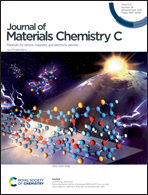Comprehensively enhanced energy-storage properties in (Pb1−3x/2Lax)(Zr0.995Ti0.005)O3 antiferroelectric ceramics via composition optimization†
Abstract
Antiferroelectric materials as one of the front candidates for high energy storage capacitors should in principle combine a small hysteresis width, high breakdown strength, large phase switching and high polarization. However, the simultaneous optimization of these parameters is a long-standing challenge. Herein, we present a superior energy storage performance of (Pb1−3x/2Lax)(Zr0.995Ti0.005)O3 antiferroelectric ceramics by composition optimization. Although La3+ doping reduces the maximum polarization, the refined grain size and increased band gap ensure high breakdown strength, and the enhanced antiferroelectric state and induced relaxation behavior lead to high phase-switching fields and a small hysteresis width, respectively. As a result, an optimal recoverable energy density of 12.3 J cm−3 and a high efficiency of 84% are achieved simultaneously under 42 kV mm−1 in the (Pb0.925La0.05)(Zr0.995Ti0.005)O3 ceramic, resulting in a remarkable energy storage performance that exceeds most antiferroelectric ceramics. Additionally, this ceramic also has a pretty excellent energy density (>8 J cm−3) under temperatures from 60 to 120 °C and frequencies from 1 to 100 Hz. All features highlight (Pb0.925La0.05)(Zr0.995Ti0.005)O3 ceramics as a potential candidate for high energy storage applications.



 Please wait while we load your content...
Please wait while we load your content...